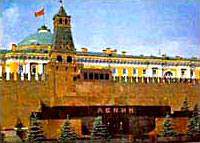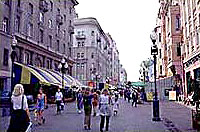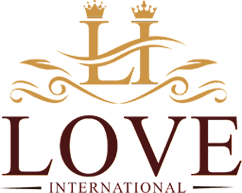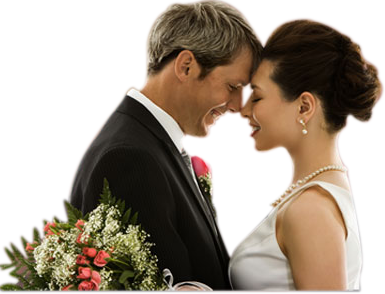Info about Moscow
 |
| The Lenin Mausoleum |
A reference to Moscow, as a town, is recorded in an old manuscript of 1147. In 1156, Prince Yury Dolgoruky erected timber walls around Moscow along with a moat. He is frequently regarded as a founder of Moscow, and his monument is among the most honored in Moscow. The Tatar-Mongolian invasion in 1237-38 produced great destruction of Moscow. However, Moscow recovered rather rapidly (in the second half of the 13th century), and became the capital of the independent Moscow principality.
 |
| The Arbat |
Moscow was attacked by the Polish-Lithuanian army in the 17th century and was conquered by them. Then the salesman Minin and the Prince Pozharsky organized the People's Militia, and Moscow was liberated in 1612. During the reign of Peter the First, arts and science in Moscow, as well as the whole of Russia, progressed strongly. In 1703 the first printed newspaper ("Vedomasti") appeared, and in 1755 Moscow University was opened. Moscow architecture reached its peak level of perfection in the second half of the 18th century due to advanced Russian architects V.I. Bazhenov (Pashkov's house), and M.F. Kazakov (Senate building).
In the 19th century Moscow remained an important political, governmental and economic center. During the French invasion Napoleon said: "If I capture Kiev, I take Russia by its feet, if I capture Petersburg, I take it by its head and if I capture Moscow, I destroy its heart". A folk army had been organized in 1812 to withstand the French invasion. The famous Borodino battle took place in August not far from Moscow. This battle is thought to be a prerequisite for the victory in the war, although the battle itself was more a failure than a victory. Moscow was left to Napoleon's troops, but before that happened, Muscovites burnt Moscow almost entirely. Fires and hunger compelled the French army to leave Moscow, which the Russian army entered soon - in October. After the liberation of the city a commission was authorized for the reconstruction of Moscow after the fire, and talented architects were its members (Beauve, Grigoriev). The present-day appearance of the center of Moscow was founded in those times. Thus, Alexandrov Garden, and Theatre Square appeared with the Bolshoi and Maly theatres, as well as the buildings of Manezh and the first gradskaya hospital.
 |
| The rivers and bridges of Moscow |
The 19th century was known to be a "golden age" for arts and science, and Moscow was the birthplace for many famous artists, writers, painters and scientists; a number of outstanding politicians were also Muscovites. You are, of course, familiar with the following names, whose talent and ideas were the glory of Russia: Pushkin, Gogol, Tolstoi, Chekhov, Herzen, Pirogov, Sklifosofsky, Vasnetsov, Serov, Levitan and many others.
 |
| The Don monastery |

|
|
Copyright © 1995-2026 |

